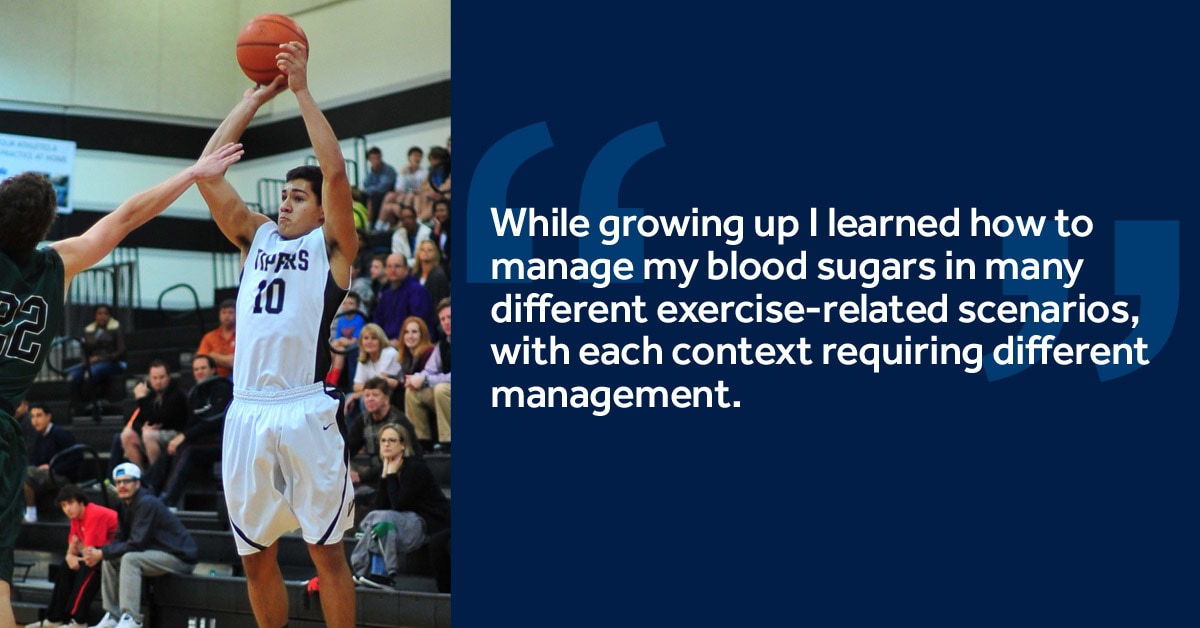Balancing diabetes and exercise

Whether you learned it from a movie or a CNN report, you probably know exercise releases endorphins—a pivotal hormone in your body’s reaction to pain and stress that is essential to your health. What’s more, aerobic exercise is the baseline for a robust metabolism and one of the building blocks of a balanced lifestyle. With that in mind, let’s talk about what an exercise plan looks like in the context of your diabetes management.
As we go through these, keep in mind that exercise plans are not one-size-fits-all. Your goal should be to put together a regimen that reflects where you are in your journey with both diabetes and exercise.
Talk to your HCP
Before you get into the details and timeframe of your exercise plan, talk to your healthcare team. Depending on your medication regimen and how recently you’ve restarted your physical activity, your healthcare provider may recommend varying intensities of exercise to fit your current fitness level.
For now, don’t head straight into the barbell racks and suicide sprints. Especially if you’re months or years removed from your last workout, medical advice will likely direct you to some even-keeled aerobic exercise and potentially some light strength training or weight lifting. In addition, if you’re regularly taking insulin, it’s especially necessary to be careful with new activity as exercise lowers your blood sugar. Find a best practice with your to monitor your glucose levels with a change in exercise.
Remember to be patient with your body as you test this new relationship with diabetes and exercise. The best thing to do is to ease back into workouts through a gradual uptick that gives your body time to adjust to elevated cardiovascular activity.
Vary your exercise
A great exercise plan works muscle groups on a regular, rotating basis. As you ramp up to your healthcare provider-recommended plan, consider how you can consistently do several types of workouts to make sure you’re giving each body part the attention it needs.
The most important type is intermittent aerobic exercise. The Department of Health and Human Services recommends around 150 minutes of moderate cardio a week to stay healthy. When you’re beginning a new plan, find a way to break this time evenly throughout the week. Start off by exercising for 30 minutes over five days. It doesn’t have to be overly intensive either—try a brisk walk around the neighborhood to get your heart rate up a bit.
In consultation with your healthcare provider, make room in your schedule for some weight or resistance training as well. As mentioned, you can hold off the bigger weights for the time being. If your doctor agrees, start with light dumbbells or bands. In fact, the American College of Sports Medicine says weight training is helpful for blood glucose regulation, so it’s helpful for diabetes management—among its heaps of other physiological benefits.
Just as with aerobic exercises, start where your body feels comfortable. If you had been active before and kept weight journals, refer to your early weight classes for where to get restarted. If the process is new or you’re coming back after a while, start at the lower end of the dumbbell rack—moderation and patience are the name of the game here.
In either event, stick to a consistent regimen. Start with sets that range from eight to 12 repetitions. Adjust depending on how you’re feeling as well as the doctor-recommended acceleration of your weight training. Consistency is a huge factor as you start your journey balancing diabetes and exercise.
If either of these more typical exercise techniques grows tiresome or dull, many great options to break up the routine a bit and mix things up in your exercise plan. You can try yoga and Pilates and also some more holistic practices like tai chi, which helps prevent stress and manage blood glucose levels.
Listen to your body
Whatever you decide when you put together your exercise plan, remember that planning a workout schedule is a journey. You won’t reach your full strength overnight. In conjunction with other elements of your diabetes and exercise management, it’s important to be aware of how you’re feeling as you ease into more strenuous training.
On top of that, be conscious of overexertion, especially in the early stages. Those first few weeks and months are the time when you get to acclimate your body because of how exercise affects your glucose levels. To simplify glucose measuring before and after exercise, consider using a continuous glucose monitor (CGM) that connects to your phone, such as the Medtronic Guardian™ Connect CGM system. While it’s important to keep active as part of your diabetes management, you should work with your doctor to keep an eye on how your blood glucose is changing over the course of exercise, and learn the correct way to manage it going forward.
Needing to take a step back on the level or amount of exercise, even after periods of continuing well-paced advancement in your workout routine, is totally common. Give yourself a break and go back to the basics—steady, consistent cardiovascular work spaced out with intermittent strength training.
Getting into a workout routine is always met with resistance from your body. But by taking into account both aspects of diabetes and exercise—the variety of exercises, the right muscle groups to hit, and key input from your medical professionals—you can give yourself a solid plan to get into a routine.
Guardian™ Connect System is for ages 14-75. Requires Rx, BG testing, proper mobile device w/ correct settings. For details, see http://bit.ly/GCRisks



